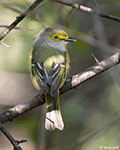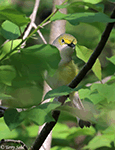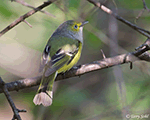| Length: 5 inches | Wingspan: 8 inches | Seasonality: Rare Migrant |
| ID Keys: White eyes with yellow "spectacles", two white wing-bars, olive-gray upperparts, lighter gray below. | ||
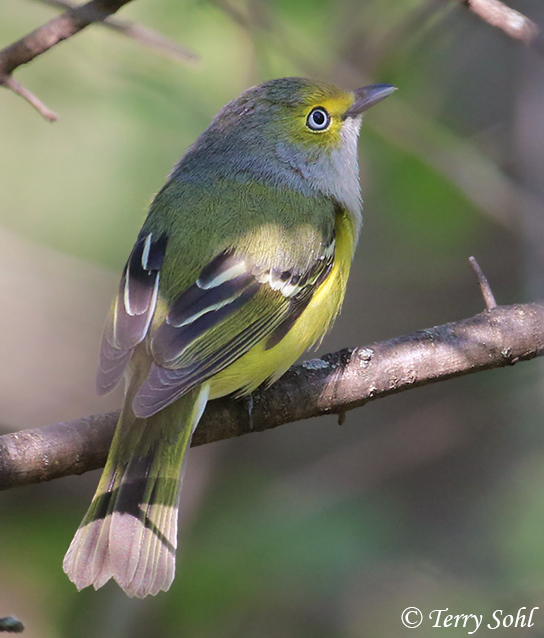 The White-eyed Vireo is a bird of dense
undergrowth and shrubby areas of the eastern United States. Their songs
can be wildly variable, having been described as "quick-with-the-beer-check!",
"chick-of-the-village", and "pick-up-a-reaaaal-chick!".
They also will occasionally mimic the songs of other birds. Their range
has varied wildly over the course of recorded history in the eastern United
States. For many years, they bred in Michigan and Wisconsin, but now
generally remain south of those states. They were once fairly common in
Massachusetts, disappeared for a period of time, and then reappeared. In
South Dakota, they are but a very rare visitor, with a handful of records.
The White-eyed Vireo is a bird of dense
undergrowth and shrubby areas of the eastern United States. Their songs
can be wildly variable, having been described as "quick-with-the-beer-check!",
"chick-of-the-village", and "pick-up-a-reaaaal-chick!".
They also will occasionally mimic the songs of other birds. Their range
has varied wildly over the course of recorded history in the eastern United
States. For many years, they bred in Michigan and Wisconsin, but now
generally remain south of those states. They were once fairly common in
Massachusetts, disappeared for a period of time, and then reappeared. In
South Dakota, they are but a very rare visitor, with a handful of records.
Habitat:
Uses a variety of shrubby low growth for breeding, including, forest edges, woodland undergrowth, overgrown pastures, and shrubby streamsides. They also prefer shrubby habitats during migration and in winter.
Diet:
During summer months, they feed almost exclusively on insects, especially caterpillars, moths, and butterflies. They also will eat fruits, berries, snails, and small lizards and salamanders.
Behavior:
Climbs and flits through foliage and branches, gleaning insects as it moves. Will sometimes hover and glean insects from foliage. Compared to many other vireos and songbirds, they tend to forage relatively close to the ground, in thickets and shrubby forest undergrowth.
Breeding:
Non-breeder in South Dakota, with no confirmed breeding records in the state (although records do exist close to South Dakota). On their breeding grounds, White-eyed Vireos construct a cup-shape nest of leaves, grasses, rootlets, twigs, and other vegetative material, often covered with leaves, mosses, and lichens on the outside, and lined with fine grasses, hair, or rootlets on the inside. Spiderwebs are used to bind much of the nest together. Nest placement is low in a shrub or small tree, in the fork of a branch between 1 and 8 feet from the ground. The female lays between 3 and 5 eggs, with both the male and female helping to incubate them. The young hatch after about two weeks, and fledge from the nest after only 10-12 days.
Song:
Variable jumbled song, with musical and harsh notes interspersed, and often ending with sharp notes. They are known mimics as well, sometimes mimicking the songs and calls of other bird species, which makes identification by voice alone sometimes difficult. Overall they are capable of an astonishing array of vocalizations.
1Click here to hear the call of a White-eyed Vireo, recorded in Port Canaveral, Florida
2Click here to hear the song of a White-eyed Vireo, recorded in Hidalgo County, Texas
3Click here to hear a song of a White-eyed Vireo, recorded in Bosque County, Texas. The original recorder noted he thought the song sounded like the vireo was trying to imitate a Carolina Wren.
Migration:
Summers throughout much of the eastern United States, as far north as Iowa, Ohio, and Pennsylvania. Winters in the extreme southeastern U.S., Mexico, and parts of the Caribbean.
Interactive eBird map:
Click here to access an interactive eBird map of White-eyed Vireo sightings
Similar Species:
If seen well, the distinctive eye and plumage pattern are conclusive for identification. However, they can be confused with multiple other vireo species
- Bell's Vireo - Both may share the same overall structure and "vireo bill", but plumage and other differences are obvious. Bell's Vireo have a dark eye compared to the namesake white eye of a White-eyed Vireo. Bell's Vireo are not as colorful, with primarily brownish, gray, and white tones compared to the olive upperparts and yellow flanks and face of a White-eyed Vireo. Bell's Vireo lack the strong facial pattern of a White-eyed Vireo
- Yellow-throated Vireo - Both species share the same structure and white and yellow plumage with darker upperparts. However, the Yellow-throated Vireo has (surprise!) a yellow throat, compared to a gray throat on a White-eyed Vireo. The head of a Yellow-throated Vireo is a yellowish green overall with a yellow "spectacled" look, while the head of a White-eyed Vireo is primarily grayish with a yellow eye "mask". The eye of a Yellowthroated Vireo is dark compared to the (surprise!) white eye of a White-eyed Vireo
- Blue-headed Vireo - The plumage pattern on the body is somewhat similar between the two species, with olive-green upperparts, yellowish coloring on the flanks, and white underparts. However, the Blueheaded Vireo has a gray head with white "spectacles", while the White-eyed Vireo has yellow spectacles. Eye color also differentiates the two species, with a dark eye on the Blue-headed Vireo and a white eye on the White-eyed Vireo.
South Dakota "Hotspot"
Given the rarity of White-eyed Vireos in South Dakota (Less than a dozen sightings recorded in eBird as of 2019), there is no "hotspot" where a birder can reasonably expect to find a White-eyed Vireo. However, they have now been seen a couple of times at Newton Hills State Park, in the same location along the trail from the Horse Camp along Sergeant Creek.
Conservation Status:
Populations can fluctuate wildly at the northern end of their range, as there have been intermittent periods where they summer quite a bit further north than their current range. However, overall, populations appear to be on the increase. They are common in parts of their range, and they are found over a broad geographic area. The IUCN considers the White-eyed Vireo to be a species of "Least Concern".
Further Information:
1) WhatBird - White-eyed Vireo
2) Audubon Guide - White-eyed Vireo
Photo Information:
Photo taken on May 15th, 2019 at Newton Hills State Park in South Dakota - Terry Sohl
Audio File Credits:
1Paul Marvin, XC452047. Accessible at www.xeno-canto.org/452047
2Paul Marvin, XC452765. Accessible at www.xeno-canto.org/452765
3David Sarkozi, XC424513. Accessible at www.xeno-canto.org/424513
| Click on the map below for a higher-resolution view |
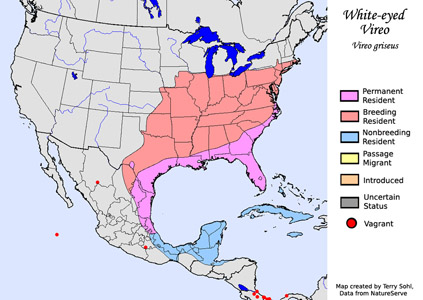 |
| South Dakota Status: Rare migrant. |
Additional White-eyed Vireo Photos
Click for larger full-res versions
